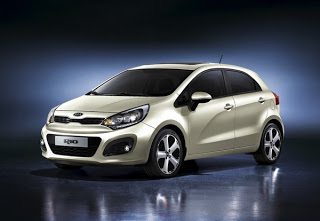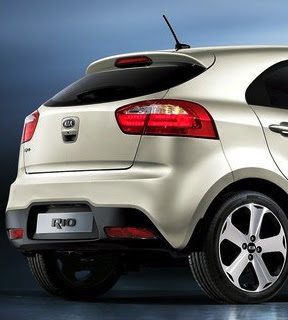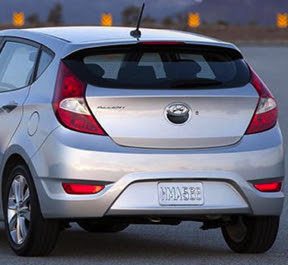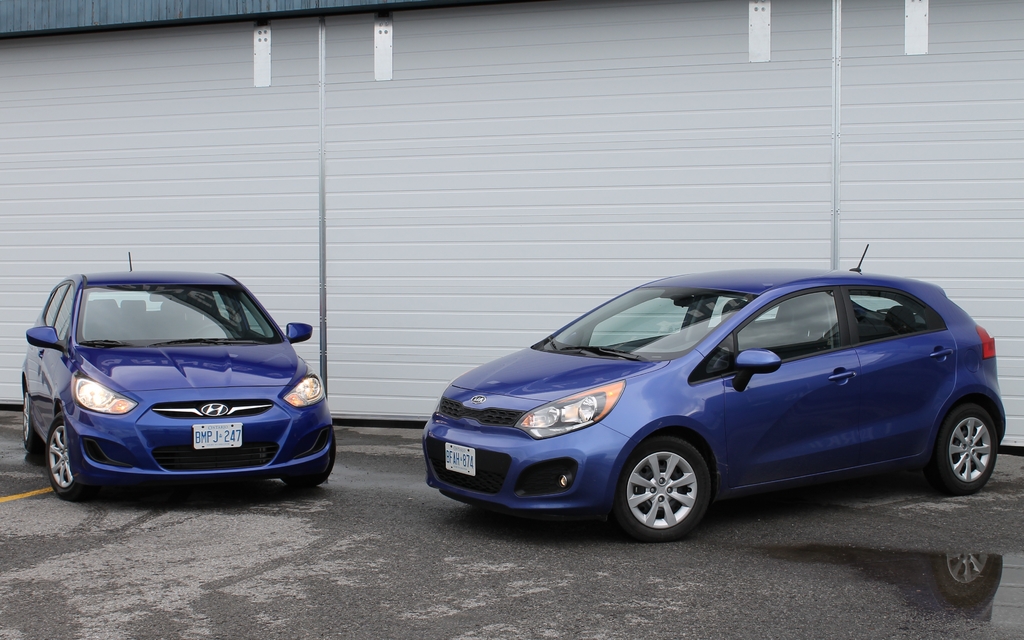2012 Hyundai Accent vs 2012 Kia Rio In Pictures
Sharing a 101.2-inch wheelbase and an engine lineup, the design paths of the 2012 Hyundai Accent and 2012 Kia Rio diverged in a wood, and Kia chose the more stylish route. That’s not to say the 2012 Hyundai Accent isn’t a handsome hatchback, GoodCarBadCar.net sees huge sales in its future, even more so after driving a 2012 GL Sedan. But from the rear, the 2012 Kia Rio is undoubtedly (beauty-in-beholder’s-eye factor notwithstanding) a more cohesive package. Moreover, Hyundai’s images of the new Accent make the hatchback’s wheels appear terribly tiny when viewed from the rear three-quarter. The Rio, on the other hand, has strong five-spokers which could fool you into thinking this is the sporty high-output Rio derivative.
This is by no means the first time The Good Car Guy has thrown two Hyundai/Kia platform-mates into an image comparison. Some of the more popular posts on GoodCarBadCar.net include the Kia Sportage vs. Hyundai Tucson photo comparo as well as the Kia Optima vs. Hyundai Sonata contrast from this past November. Of course, the new Kia Rio and the new Accent must face off against other rivals, too. The 2011 Ford Fiesta is a capable, high-tech, fuel-efficient hatch with the now desirable Blue Oval badge. The Honda Fit is a tremendously roomy hatchback, one that’s surprisingly fun to drive. And Ford’s disconnected sibling, the Mazda 2, is attractive and more fun overall than the Fiesta.
Nevertheless, these eight images are meant to showcase the differences between two Korean hatchbacks, vehicles which will invariably feature low MSRPs and heady levels of equipment. We already know the Accent will be fitted with 6-speed transmissions and a full slate of safety gear – one would assume the Rio won’t go without such niceties. Kia’s press release for the 2012 Rio says some markets will also receive a 3-door hatchback and 4-door sedan. So there will be differences (the Accent is a 4-door sedan or 5-door hatch only) in the cabin and perhaps even the driving experience, but the most unique aspects of these two cars is surely the exterior design. Until more pictures become available, satisfy yourself with the two 2012 Kia Rio Galleries and The Good Car Guy’s brief analysis after the jump.
Not too many years ago, we would’ve paused a moment and contemplated the largesse of the Rio’s headlamps. Now, the over-the-top front end seems simply to be a uniquely Kia take on the typical OTT front fascia. The gaping air intakes remind me of the 2011 Volvo S60 (its photo gallery can be seen here) while the narrowly connected grille is the main connector to the 2011 Kia Optima. Merely noticeable from the front, the scalloped sides of the 2012 Rio are downright eye-catching when you stare straight at the Rio’s taillamps from the corner of the car. Arching straight through the door handles, the two character lines which cause the concave surface help the small hatchback escape without appearing hefty while at the same time provoking visual interest. Details like the Kia badge sitting atop the trunk release are the sort of thing you wouldn’t have expected to see so nicely turned out on a Kia of yore.
The 2012 Kia Rio’s rear has something of an old Seat Leon look to it, but it’s also a little Ford Of Europeish. These aren’t bad things, and no copycat criticism should be laid on a company for its latest hatchback. It’s a two-box car – there are only so many places you can take a product with an engine room, a cabin, and four wheels.
On to the Accent, the overall look is a little bit safer; a little bit more mature; a little bit more of what you’d expect. Let’s not get ahead of ourselves: both cars are pleasantly-styled; neither car is ahead of the game or one bit avant-garde. Even so, where the Rio is more stylish in the moment, the Accent is clean and purposeful and features less you could dislike. Parked side by side the Accent might seem a little boring, but we should give credit for a few strong features.
First, the hood’s shutline is enormously apparent but the eye remains drawn to a dose of character as things go concave where normally you’d see power bulges. In the same spot on the rear of the car is a lip just below the rear window that contributes to a very BMW 1-Seriesesque presentation. It’s also obvious from the rear that this car, like the Rio, seems to offer a narrow slit for a backlight. That’s a sacrifice for style. In these initial pictures the Accent looks to be the longer, lower car, truly a trick of designers and/or photographers. Besides that strange concave shape on the hood, there are a few other regions of the car that make the Accent look like the serious big brother of the two.
There’s droopiness over the license plate surround at the back. There’s extra glass behind the rear door windows that the sportier Kia doesn’t have. And that lip below the hatch’s window must be there for a reason, and the reason can’t be straight up style.
All in all, judging only on appearances, the Accent will look more current in ten years; the Rio is cooler now. And why do the exterior designs of two subcompacts matter so much to The Good Car Guy? Aren’t these econoboxes acquired based on the best deal available? Consider this: in a thousand ways, the 2012 Kia Rio and 2012 Hyundai Accent are the same car. Driving them won’t feel all that different. Paying for one won’t be dramatically more expensive than paying for the other. Fuel economy will be the same. What’s that leave? Style, my friends, style. Look as good as you can.
2012 Kia Rio5 vs. Hyundai Accent: Quarrelling twins
Are the Hyundai Accent and Kia Rio5 twin hatchbacks? Maybe on paper, but not in pictures (see our photo gallery). When the time comes to put your money where your mouth is and choose, you should know that one offers a lot more than the other.
Don’t let the term “small car” fool you. Never before have these small cars offered so much quality, style and equipment at such a low price. The new Accent and Rio5 are a head and shoulders above the competition, in part because they offer features that you never (or rarely) find in this category, such as heated seats and steering wheel, sunroof, direct fuel injection engines (for a meagre combined fuel consumption of less than 6 L/100 km), and six-speed manual and automatic transmissions.
Their major fault is their average soundproofing, but considering they meet compact car dimensions, both of these Korean models can boast good headroom and decent legroom in back (note to your knees: the Accent is 8 cm longer than the Rio5). The interior assembly is nice, the controls are easy to master, overall comfort is very satisfactory and the same goes for performance.
We could stop right there, but let’s look a little further. In fact, we will look at which of the two comes out ahead in six different categories:
1) Style: Taste is everything
The new generation Accent came on the scene last summer in four- and five-door versions. Meanwhile, the Rio subcompact came out last fall as a five-door version, with a sedan to be introduced at the end of the year.
Obviously, style is a question of taste. However, I prefer the look of the Accent, which I find more elegant than the jelly bean-shaped Rio5. Ok, so the fact that the same Mercedes-inspired fluid lines are used on the Accent, Sonata and Elantra dilutes the novelty somewhat, but you can’t deny that this classic style stands the test of time and beats Kia’s less defined design hands down.
The Accent’s passenger compartment is also more original with blue lighting, black lacquer accents, original fabric upholstery and modern instrumentation. The Rio5’s interior is colourless, uninspired and saddled with average plastics. I do like the small compartment in the Rio5’s dashboard, but the storage compartments in the doors are slimmer than those in the Accent.
So, the Accent’s style gives it a 1-0 lead.
2) The lowest price? Go for the Versa!
Want a subcompact for less than $10,000? Forget it. Firstly, the Koreans are no longer willing to just give everything away. Secondly, the three-door version of the Accent no longer exists.
That means that if you’re looking for THE least expensive car presently on the Canadian market, you’ll have to turn to the new Nissan Versa sedan at $11,798.
Between our two Korean rivals, the Accent that offers the lowest sticker price at $13,599 (manual gearbox). That’s $500 less than the Rio5 base version, and $600 less if you opt for the automatic transmission. But at that price, the Accent doesn’t include power locks and windows, heated mirrors or audio controls on the steering wheel, which the Rio5 base version includes, in addition to its 15-inch tires (versus 14 inches with the Accent).
The Rio5 takes this one because of its more complete offer.
3) The sweet spot
Let’s continue to talk budget: most new Accents and Rio5s will be sold in their mid-end versions: GL for the Accent (at $15,399), LX+ for the Rio5 (at $15,595). That means you barely pay $200 more for the Kia, or $300 if you go for the automatic transmission.
Comparing these trims, both have pretty much the same additional equipment, beginning with air conditioning and cruise control. The additional $200 for the Kia is justified by the heated front seats and fog lights, which the Hyundai does not offer on this version.
So it’s a dead heat for our two Koreans.
4) Two personalities
Drive one after the other and you’ll notice that each features its own unique personality. Despite sharing the same platform, rear torsion bar suspension, power steering and countless other parts (notably the 138-hp 1.6-litre four-cylinder engine), the Accent proves less solid than the Rio5.
On the other hand, the Accent’s suspension floats over bumps in the asphalt while its steering, provided by an unpleasant, thin steering wheel, has no soul. It’s comfortable, but it lacks substance.
The Kia’s larger steering wheel, more rounded stick shift, more precise steering and a firmer suspension give it more solid, better balanced performance. Moreover, the manual transmission’s gear ratio isn’t handicapped by an excessively long second gear like on the Accent.
So, the Rio5 gets a point for ride.
5) Establishing dominance
Until now, the Rio5 had been protecting a slim lead, but this is where the Kia pulls out in front for good.
The difference is its $20,795 EX Luxury variant, for which the Accent has no equivalent. That includes (hold on to your hat): 17-inch wheels, sport suspension and aluminum pedals, keyless start, heated steering wheel (!), air conditioned glove compartment (!!), artificial leather upholstery, windshield wipers that react to rain, automatic air conditioning and back-up camera.
And don’t forget the UVO, developed with Microsoft – “a Sync that works,” as the folks at Kia call it. Hyundai USA will one day have its BlueLink, but nothing has been confirmed for Canada as yet.
Another point for the Rio5!
6) The death blow: Stop and Go
Viewed that way, and if we forget the interior and exterior style, the Rio5 offers enough to supplant the Accent. But there’s more: the Kia can come in the Eco version ($17,695), which means that it has one of the most fantastic systems out there, the Stop and Go. Unfortunately, it isn’t used widely enough yet.
This device cuts the engine once the car is immobilized, such as at traffic lights. This system is very nice, reducing fuel consumption significantly. Unfortunately, apart from hybrids, very few North American cars are equipped with Stop and Go, and it’s a shame. What can you do, it adds a couple hundred dollars to the price and, even though drivers seem to have more money in their pockets, they don’t yet see the benefits of slashing fuel consumption. Good thing Kia wasn’t afraid to add it as a means of testing consumer response.
A “death blow” point for the Rio5.
Conclusion
This last point alone would have been enough to give the Rio5 the win, but Kia was already ahead in every category, except style.





